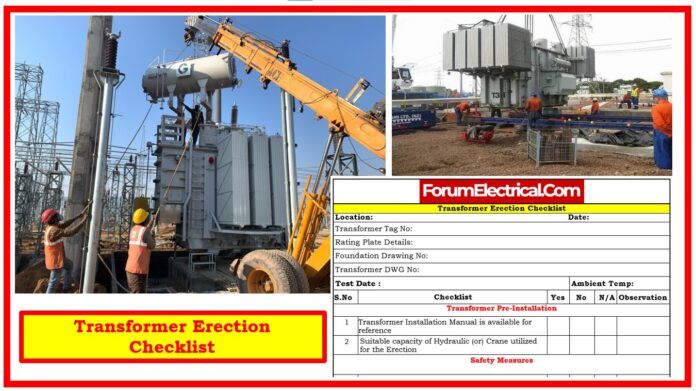Table of Contents
Creating a detailed transformer erection checklist is essential for a smooth, safe, & efficient installation procedure.
This checklist can be customized to the specific type of transformer & site conditions.
Below is a complete checklist that covers the various steps of transformer installation:
Transformer Pre-Installation Checklist
- Ensure that all essential permissions & approvals are in place.
- Consult the manufacturer’s installation manual & technical specifications.
- Ensure that all engineering drawings & site plans are available.
- Site Preparation
- Confirm that the transformer groundwork (foundation) is complete and meets the design criteria.
- Check for adequate grounding & bonding at the jobsite.
- Make sure the location is free of debris and appropriately leveled.
Equipment & Tools
- Check the availability of all required tools & equipment (cranes, rigging gear, and safety equipment).
- Inspect lifting & handling equipment to ensure it is certified and safe.
Safety Measures
- Conduct a safety briefing for all individuals involved in the erection procedure.
- Ensure that all workers have access to and use personal protective equipment (PPE).
- Check the availability of first-aid kits & emergency contact information.
Transformer Arrival & Inspection
- Inspect the transformer for evident damage during shipping.
- Check that all components & accessories are there, as specified on the packing list.
- Document any differences or damages & notify the provider right away.
- Follow the manufacturer’s instructions for unpacking the transformer.
- Ensure that no damage occurs throughout the unpacking procedure.
Pre-Installation Tests
- Perform insulation resistance (IR) tests.
- Conduct oil tests on transformers that are filled with oil.
- Check the tightness of any external connections.
Transformer Erection
- Place the transformer on the foundation in accordance with the layout plan.
- Align the transformer using the appropriate alignment tools.
- Assemble all external components, including bushings, radiators, conservator tanks, and fans.
- Ensure that all components are properly secured and properly aligned.
- Connect primary & secondary cables, or busbars.
- Make that all electrical connections have the necessary torque.
- Install grounding cables per the grounding plan.
- Follow the right process for filling the transformer with oil.
- Perform degassing & dehydration as needed.
- Check oil levels and check there are no leaks.
- After installation, conduct final checks and testing.
Testing
- Perform an extensive visual check of the transformer.
- Perform final electrical testing such as insulation resistance, winding resistance, & ratio tests.
- Check the operation of all cooling systems & control devices.
Commissioning
- Energize the transformer with supervision.
- Check for unusual noises, vibrations, (or) temperature increases.
- Keep a record of all commissioning data for the future reference.
Documentation
- Collect all test results, assessment records, & commissioning reports.
Maintenance and Monitoring
- Schedule regular maintenance inspections based on the manufacturer’s recommendations.
- Evaluate transformer performance & document any irregularities.
Oil Analysis
- Conduct periodic oil sampling & analysis.
- Check the dielectric strength, moisture content, & dissolved gas analysis.
By following this complete checklist, you can assure a methodical and safe transformer erection process, reducing the possibility of errors and assuring long-term reliable operation.









